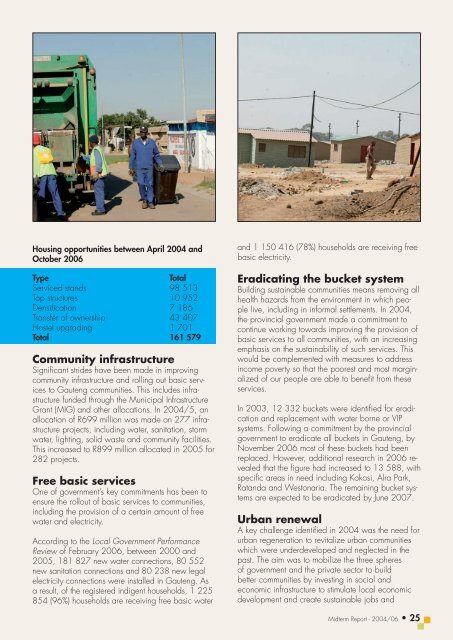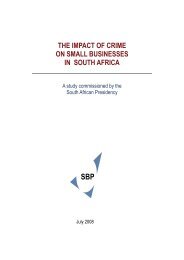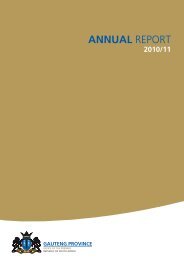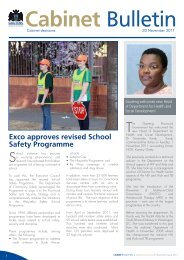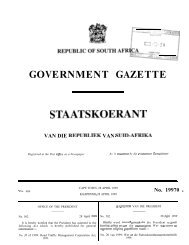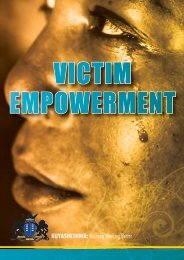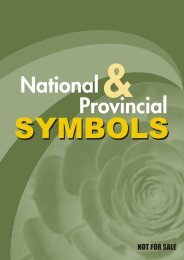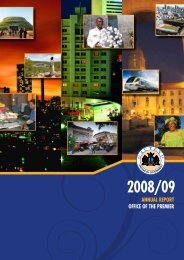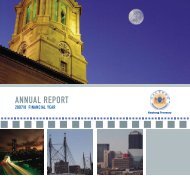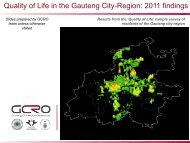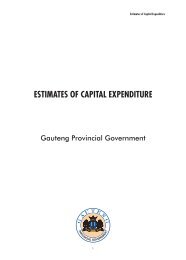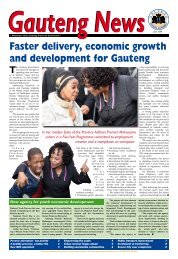Mid Term Report - Gauteng Online
Mid Term Report - Gauteng Online
Mid Term Report - Gauteng Online
You also want an ePaper? Increase the reach of your titles
YUMPU automatically turns print PDFs into web optimized ePapers that Google loves.
Housing opportunities between April 2004 andOctober 2006TypeTotalServiced stands 98 513Top structures 10 952Densification 7 186Transfer of ownership 43 407Hostel upgrading 1 701Total 161 579Community infrastructureSignificant strides have been made in improvingcommunity infrastructure and rolling out basic servicesto <strong>Gauteng</strong> communities. This includes infrastructurefunded through the Municipal InfrastructureGrant (MIG) and other allocations. In 2004/5, anallocation of R699 million was made on 277 infrastructureprojects, including water, sanitation, stormwater, lighting, solid waste and community facilities.This increased to R899 million allocated in 2005 for282 projects.Free basic servicesOne of government’s key commitments has been toensure the rollout of basic services to communities,including the provision of a certain amount of freewater and electricity.According to the Local Government PerformanceReview of February 2006, between 2000 and2005, 181 827 new water connections, 80 552new sanitation connections and 80 238 new legalelectricity connections were installed in <strong>Gauteng</strong>. Asa result, of the registered indigent households, 1 225854 (96%) households are receiving free basic waterand 1 150 416 (78%) households are receiving freebasic electricity.Eradicating the bucket systemBuilding sustainable communities means removing allhealth hazards from the environment in which peoplelive, including in informal settlements. In 2004,the provincial government made a commitment tocontinue working towards improving the provision ofbasic services to all communities, with an increasingemphasis on the sustainability of such services. Thiswould be complemented with measures to addressincome poverty so that the poorest and most marginalizedof our people are able to benefit from theseservices.In 2003, 12 332 buckets were identified for eradicationand replacement with water borne or VIPsystems. Following a commitment by the provincialgovernment to eradicate all buckets in <strong>Gauteng</strong>, byNovember 2006 most of these buckets had beenreplaced. However, additional research in 2006 revealedthat the figure had increased to 13 588, withspecific areas in need including Kokosi, Alra Park,Ratanda and Westonaria. The remaining bucket systemsare expected to be eradicated by June 2007.Urban renewalA key challenge identified in 2004 was the need forurban regeneration to revitalize urban communitieswhich were underdeveloped and neglected in thepast. The aim was to mobilize the three spheresof government and the private sector to buildbetter communities by investing in social andeconomic infrastructure to stimulate local economicdevelopment and create sustainable jobs and<strong>Mid</strong>term <strong>Report</strong> - 2004/06 • 25


